
Eldora, previously known as "Eldorado" then "El-Dora", then Eldora or Camp Eldorado, and still called Happy Valley, is an unincorporated community and a census-designated place (CDP) located in and governed by Boulder County, Colorado, United States. The CDP is a part of the Boulder, CO Metropolitan Statistical Area. The population of the Eldora CDP was 142 at the United States Census 2010. The Nederland post office serves the area.

Victor Downtown Historical District is a 22 acres (8.9 ha) historic district encompassing several blocks of Victor, Colorado which was listed in the National Register of Historic Places in 1985. The listing included 55 contributing buildings out of 66 buildings in total. The district is bounded roughly by Diamond Avenue, Second, Portland and Fifth Streets.
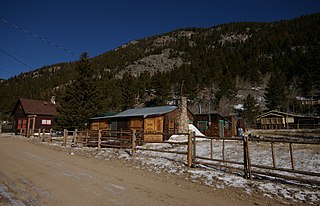
Eldora Historic District is a 30 acres (12 ha) historic district in Eldora, Colorado. Other names of the district and/or other historic names of places in the district are Happy Valley, Eldorado Camp, and 5BL758. It was listed on the National Register of Historic Places in 1989. The listing included 55 contributing buildings and 12 non-contributing ones.

The Thorstein Veblen Farmstead is a National Historic Landmark near Nerstrand in rural Rice County, Minnesota, United States. The property is nationally significant as the childhood home of Thorstein B. Veblen (1857-1929), an economist, social scientist, and critic of American culture probably best known for The Theory of the Leisure Class, published in 1899.
The National Register of Historic Places listings in Syracuse, New York are described below. There are 110 listed properties and districts in the city of Syracuse, including 19 business or public buildings, 13 historic districts, 6 churches, four school or university buildings, three parks, six apartment buildings, and 43 houses. Twenty-nine of the listed houses were designed by architect Ward Wellington Ward; 25 of these were listed as a group in 1996.

The Meadows is a historic home and farm compound located at Owings Mills, Baltimore County, Maryland, United States. The house is an L-shaped 2+1⁄2-story stone house built in the 18th century and occupied for approximately 80 years by various members of the Owings family, for whom Owings Mills was named. Also on the property is a 2+1⁄2-story stone slave house, an 18th-century stone and timber stable, and a 2-story log and clapboard tenant house.

Minertown-Oneva, also known as Minertown, in Forest County, Wisconsin is a historic logging camp built in the early 1900s by Wilbur and Henry T. Miner. It's in the vicinity of Carter, Wisconsin.
Crow Hill, also known as Charles Whiting Residence, is a historic home located at Kinderhook in Columbia County, New York. It was built in 1839 and is a 1+1⁄2-story, nearly square and symmetrical, wood-frame dwelling with clapboard siding in the Greek Revival style. It has a hipped roof with cupola centered over the main hall. It was framed with recycled parts of old barns and perhaps earlier homes. Also on the property is a 19th-century wood well house.

The Samuel I. Hallett House is located on West Francis Avenue in Aspen, Colorado, United States. It is a timber frame structure built in the late 19th century. In 1987 it was listed on the National Register of Historic Places.

The Thomas Hynes House on East Main Street in Aspen, Colorado, United States, is a wooden building from the 1880s. In 1987 it was listed on the National Register of Historic Places as part of a group of historic properties in the city.

The Osgood–Kuhnhausen House, also known as Carina's Cottage, is located on Redstone Boulevard in Redstone, Colorado, United States. It is a timber frame structure built at the beginning of the 20th century in the Tudor Revival architectural style. In 1983 it was listed on the National Register of Historic Places.
Boulder Crescent Place Historic District is a historic area in Colorado Springs, Colorado along West Boulder and Cascade Avenue near the intersection of the two streets. It is a National Register of Historic Places listing and is on the Colorado State Register of Historic Properties.
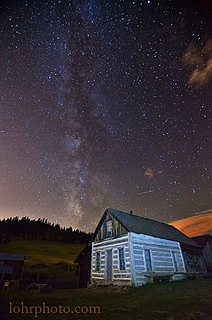
The Walker Ranch is a historic ranch in Boulder County, Colorado. The ranch was built by James A. Walker, who first settled in the Boulder area in 1865. Walker and his family initially lived in a log cabin on the ranch, which was built in 1865. In 1881, Walker and his family built and moved to a new ranch house. Walker engaged in a number of business ventures on the ranch and leased parts of the ranch to other businessmen, and the enterprises which took place on the ranch represent many of the region's industries at the time. Walker mainly raised cattle and milled lumber on the property, and an English firm mined gold using a cyanide mill; payments from the latter operation allowed Walker to eliminate his debt and purchase additional land for the ranch. Of the remaining historic buildings on the ranch, eleven are from Walker's homestead and his ranching operations, fourteen were part of Walker's sawmill operations, and fourteen are related to the cyanide mill. The ranch also includes five archaeological sites; three of these are remnants of aboriginal settlement in the area and two of these are Arapahoe sites, including a site Walker may have shared with the Arapahoe when he first came to the area.
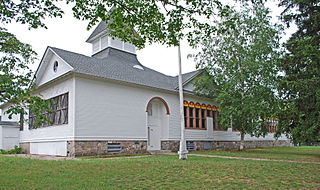
The Empire School is a school building located at 10017 West Front Street in Empire, Michigan.

The Eldora Downtown Historic District is a nationally recognized historic district located in Eldora, Iowa, United States. It was listed on the National Register of Historic Places in 2009. At the time of its nomination the district consisted of 84 resources, including 65 contributing buildings, one contributing site, three contributing objects and 15 non-contributing buildings. The district takes in the city's central business district, which also includes its governmental, educational, and religious activities. It is located in the original town plat from 1853. Development began around the public square and spread out from there. The present building stock is second generation at the earliest. The oldest extant buildings were built in the 1870s, although the greatest number of buildings were constructed in the 1890s. There were also peak years of construction in the 1910s, and the late 1930s and 1940s. The commercial buildings generally range from one to two stories, but the tallest structure is three stories in height. They are primarily composed of brick construction. Late Victorian and various revival styles from the late 19th and 20th centuries are dominant. The non-commercial buildings include four government buildings, four churches, three residences, a hospital, and a school.

The Willis House is a historic residence in Encampment, Wyoming, United States, that is listed on the National Register of Historic Places.
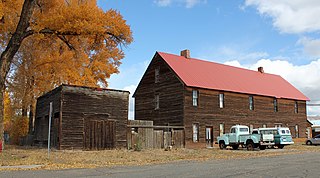
Edgerton House, at 514 W. Gunnison Ave. in Gunnison, Colorado, was listed on the National Register of Historic Places in 1998.

Columbine or Columbine Gold Camp at 8,697 feet (2,651 m) elevation in Routt County, Colorado near Clark, Colorado is a former community gold mining community, now a populated place and a rental cabin resort. It dates from around 1895. It was listed as a historic district on the National Register of Historic Places in 2007.

The Downtown Boulder Historic District, in Boulder, Colorado, is a 48 acres (19 ha) historic district which was listed on the National Register of Historic Places in 1980.
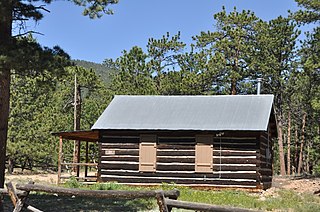
The Bunce School, near Allenspark, Colorado near the Continental Divide in Boulder County, Colorado, is a historic one-room schoolhouse built in 1888. It was listed on the National Register of Historic Places in 1986.


















